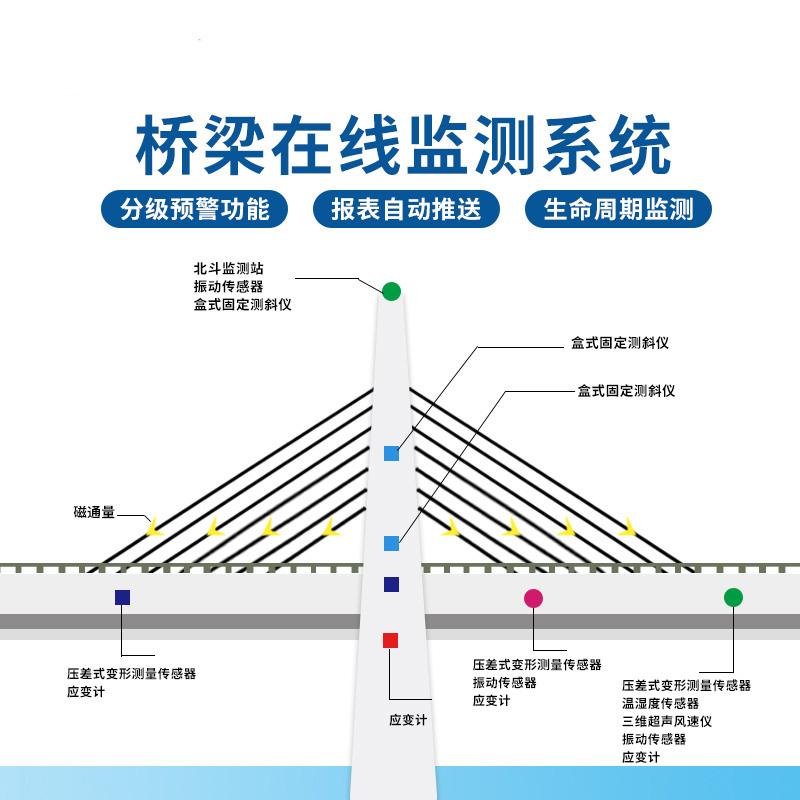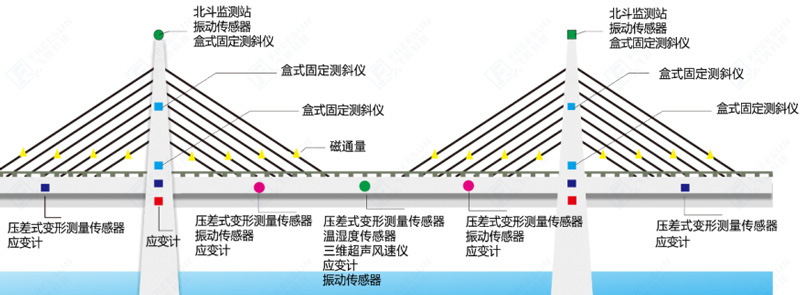Meteorological environment monitoring equipment supplier
Insist on doing high-precision customer favorite technology products

1.Bridge monitoring background
Bridge monitoring uses the sensor detection technology of the Internet of Things to real-time online monitoring of various bridge values that need to be monitored.As an important part of transportation, bridges have attracted more and more attention due to their safety, durability and normal use functions with the development of my country's transportation industry.Our country is a big country of bridges.According to the latest statistics from the Ministry of Transport, as of the end of 2019, there were approximately 878,300 road bridges (excluding municipal bridges) in our country.There are many factors that affect bridges, such as human factors, long-term vehicle overloading, material degradation, natural disasters, etc., which lead to various diseases such as reduced bearing capacity and structural damage of existing bridges.At the same time, there is a lack of timely management and maintenance.If the damage cannot be detected and repaired in time, it will affect driving safety and shorten the service life of the bridge, or lead to sudden damage and collapse of the bridge.Therefore, it is particularly urgent to establish an intelligent online monitoring system for bridges to detect damage to bridge structures in a timely manner.
2.Overview of Bridge monitoring system
Our company has many years of bridge monitoring experience, and has established an intelligent, information-based, and automated bridge online monitoring system that can fully grasp the safety status of bridge construction and operation, and plays a huge role in bridge construction, daily maintenance, management, and emergency response.effect.Based on the cloud computing service center, it can accommodate all bridge monitoring systems in the region, form a regional bridge health monitoring platform, and realize unified monitoring and management of all bridge structures in the region.
3.Main monitoring contents of Bridge monitoring
1.Geometric linear monitoring: arch rib linear monitoring, main beam deflection monitoring, axis offset measurement;
2.Stress and strain monitoring: beam body strain, bridge tower strain, main arch strain, bridge pier strain, etc.;
3.Cable force/tension monitoring: tie rod tension, suspender tension, anchor cable stress, etc.;
4.Environmental monitoring: wind speed and direction, temperature and humidity, rainfall, visibility, corrosion
7.Deflection monitoring: tower top deflection, arch foot deflection, vault deflection;
8.Vibration monitoring: beam vibration, vault vibration, bridge tower vibration, boom (cable) vibration;
9.Load monitoring: dynamic weighing system;
10.Tilt monitoring: tower tilt, bridge pier tilt, beam tilt;
11.Other monitoring: crack monitoring, fatigue monitoring, ship collision, camera.
4.Bridge monitoring monitoring diagram

5.List of Bridge monitoring monitoring projects
| Monitoring items | Device name | Monitoring items | Device name |
| stress strain | Strain gauge | expansion joint | linear displacement sensor |
| cable force | Magnetic flux sensor/accelerometer/anchor meter | Temperature and humidity | Temperature and humidity sensor |
| Vibration acceleration | accelerometer | vehicle load | Dynamic weighing system |
| Deformation displacement | GNSS, box-type fixed inclinometer | Bridge deck video | Infrared network high speed dome machine |
| Settlement/Deflection | static level | Wind speed and direction | Wind speed and direction gauge |
| crack | crack meter | earthquake | accelerometer |
6.Bridge monitoring basis
"Technical Standard for Municipal Bridge Structural Monitoring DB22∕T 5035-2020"
"Design Specification for Bridge Structural Health Monitoring System DB32∕T 3562-2019"
"Technical Regulations for Bridge Structure Monitoring Systems DG∕TJ 08-2194-2016"
"Technical Regulations for Highway Bridge Structural Safety Monitoring System JT/T 1037-2016"
"Technical Specification for Monitoring of Building and Bridge Structures GB50982-2014"
"Design Standard for Structural Health Monitoring Systems CECS-333-2012"
7.Bridge monitoring implementation function
1.Full life cycle monitoring: Realize the full life cycle monitoring of the bridge, including relevant content during the construction period and operation period, such as strain, temperature, linearity during the construction period, strain, linearity, vibration, environment, stress, etc.during the operation period, for Data storage analysis, GIS+BIM or GIS+4D model comprehensive display, grasp the status of the bridge's entire life cycle, and provide decision-making basis for management;
2.Automatic push of reports: In addition to real-time display of monitoring results, the system will automatically generate corresponding daily reports and support one-click downloading.Once the data exceeds the threshold, a timely warning can be given and relevant units can be notified to take corresponding measures in a timely manner;
3.Hierarchical warning: Set different warning levels according to requirements.When data is abnormal, warning information will be automatically triggered according to the settings, including platform push, SMS and email notification to the corresponding person;
4.Accumulate bridge status data: Provide the necessary decision-making basis for the long-term operation, maintenance, repair, and reinforcement of the bridge, and provide the basis for the safety status assessment of the bridge after an emergency.At the same time, AI algorithms are used to predict the future time period of the bridge.Structural response and development;
5.Provide reference basis: verify the design and construction theory and construction technology of the bridge, thereby improving the relevant design and construction technical regulations and ensuring the safety of the bridge.